The new Doom, really, is rather like the old Doom. You fight swarms of hulking demons. You never stop moving for fear of being swamped in laser fire, missiles and pile-driving hell knights. Your screen is permanently suffused with explosions, blood and chunks of bodies. You, the Doom Marine, are what stands between an army of demons accidentally unleashed on a Martian mining installation, and domination of our realm. Thank goodness you’ve access to such big guns.
This piece originally appeared on Kotaku UK 18 May 2016.
While Doom comes with multiplayer, the campaign is where it shines, in a pleasing inversion of the usual dynamic of modern shooters. It wastes no time. Within seconds, there is a gun in your hand and a lab of possessed scientists bearing down upon you. (That is is the collective term for scientists, right: a lab?) It’s a far cry from the plodding, story-laden start of Doom 3; instead of spending the first 20 minutes talking to NPCs, being led through a mining facility and generally getting bored, it throws you right into the action. You can play on an easier setting with tutorial popups, or on a more difficult setting with none at all. id understands its audience well enough to trust that a lot of people know what Doom is without the need for a primer on blasting things into globules.
Doom feels like a ’90s shooter. There’s no hiding behind cover, no scripted sequences, no friendly NPCs to follow into firefights. In their place are lots of first-person jumping sequences, for good or ill. The level design, too, is a departure from the bulk of big modern shooters. Rather than a linear route through corridors and tightly controlled open air rooms, you’re often let loose in an open, multi-layered space webbed with walkways, platforms and corridors, stuffed with secrets. Often, if I saw an area beneath me, I could just jump over a walkway barrier, land on it and start exploring.
There are a ton of secrets to be found in Doom, from weapons that you don’t officially find until later in the campaign to collectible toy space marines that play extracts from the original Doom soundtrack, to recreations of old Doom levels in the new engine. The level design guides you subtly towards these hidden amusements, but you have to keep your eyes and your mind open to find them; I found several by looking over the edge of a cliff and spotting a hole in the rock below. I highly advise bringing up the map screen regularly and scanning it for areas you can’t remember visiting; there are so many things you’ll spot that you missed while racing through an area clearing it of enemies. It pays to examine each level deeply. Whether with upgrade points, new gear or a new mini-challenge, you are always rewarded for doing so.
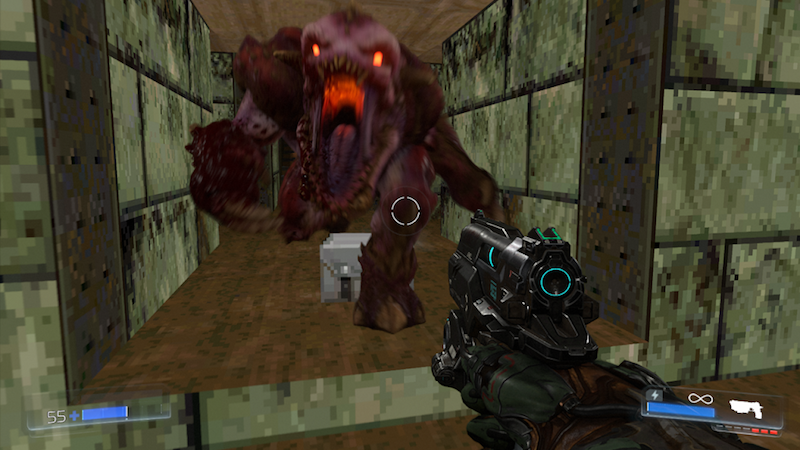
Combat-wise, the big new feature in Doom is the glory kills — a range of violent executions that you can perform on near-dead enemies. Do enough damage to an enemy and it will become staggered, standing on the spot swaying for a short time, at which point you can tap a button for the kill. Face the back of a staggered hell knight and you’ll grab the demon by its upper and lower jaw and wrench its skull in two. If you manage to stagger a Baron of Hell, then you’ll knock it to its knees, tear off one of its horns and spear the demon through the head with it.
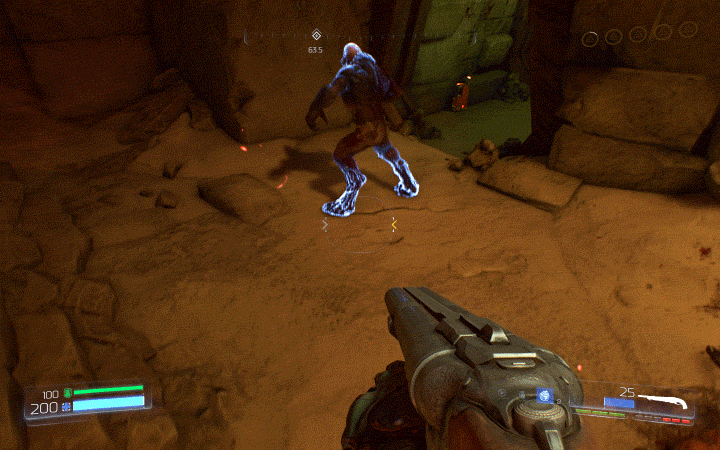
The animations are brutal and the violence is the sort of thing that would have spurred a boycott from parent groups in the ’90s. The thing is, as violent as they are, you soon stop noticing. Glory kills are not rare things. You will rely on them multiple times in every gunfight because each execution guarantees a health pick-up will drop from the demon’s corpse. The special kills become just a beat to the rhythm of combat. You will dash about the room firing shells and balls of plasma into the horde, and when you spot a demon’s skin shimmering with the telltale sign that it’s staggered, you will dive into the thick of the scrum to execute it. The action stops for the couple of seconds that it takes for the execution animations to play out, and then resumes the instant the demon dies in your hands. You get a nice little health buff and immediately go back to dancing around your enemies’ fire.
I’m torn on glory kills. At first I loved them for the hyper-violent gore — Doom‘s always been a violent game, and for me this kind of colourful ultraviolence is great, over-the-top fun. But after seeing the same animations several times over, they became a little dull, and I began to resent them for breaking up the flow of the combat. I’d be spinning about the room, never standing still for a moment, and then everything would come to a halt to watch a second or two of canned violence. There were also times that I was actually annoyed when I got a one shot kill with a weapon, because it meant I didn’t get a health pickup. I should never be disappointed that I blasted a demon into chunks of meat with a single blast from the Super Shotgun. Never.
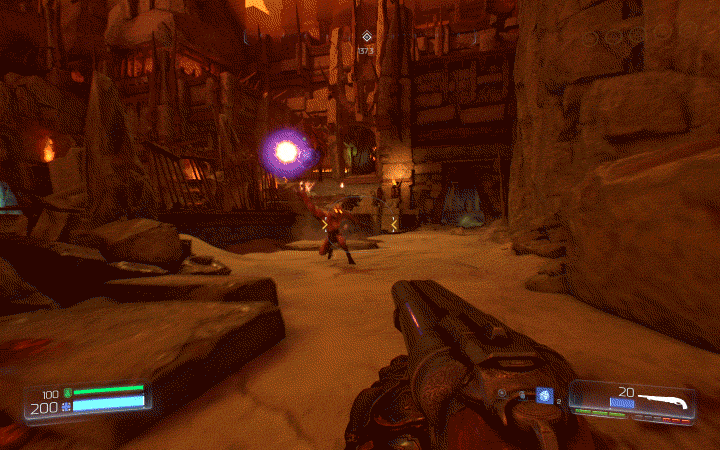
Towards the end of the game, though, where you can be in constant battle for several minutes and you’ve used all the health packs in an arena, having a way of refilling your health bar becomes essential. At that point, glory kills become tactically vital.
The still-beating heart ripped from the chest of Doom is excellent, fast and bloody combat in open spaces. At the end of a long fight, when the heavy metal music died down after I’d killed the final demon of the last wave, I’d often find myself releasing a breath of relief I hadn’t even realised I was holding. These intense moments aren’t confined to the end of the campaign, but occur throughout the single-player. The first room after I found my shotgun (which I had to tear out of the hands of a dead marine) on the first level had me holding my breath, and that was just fighting imps; there wasn’t a cyberdemon in sight.
Seriously, I lay in bed last night with my wrist pulsing with a dull pain after playing Doom solidly all weekend. I don’t know if it’s an endorsement of a game to say I think it’s giving me carpal tunnel, but there you go. There is no mainstream shooter campaigns I can think of that has made me feel like this — though it could be that I’m just getting old and my wrists are starting to give out.
Doom doesn’t just rely on enemy volume to make you feel like your heart’s beating out of your chest. The way that the demons use space pushes you to keep moving. Imps will keep to the sides of the room, climbing up walls and getting high above you to fling fireballs at you from a distance. Pinkys, Doom‘s muscle-bound demon dogs, will charge at you, forcing you to play matador if you want to stay healthy. Possessed soldiers will quickly turn to face you, always keeping their body safe behind the shield, making you leap over them in order to outflank them. The AI pushes you to play with the quick step of the older Doom games — constant movement is key to winning every fight.
When you get your thrust boots and unlock the ability to double jump, movement and combat get even more energetic, as you can easily bounce over a horde of enemies. It gave me flashbacks to the acrobatics of Quake Arena.
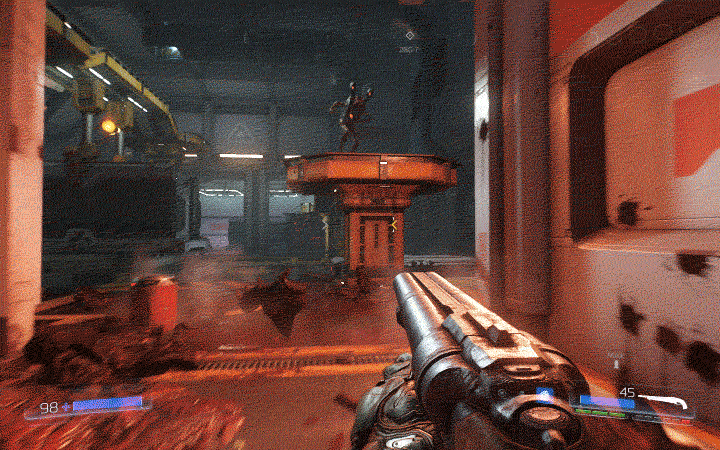
Thanks to id’s talent for packing swarms of highly-detailed, fast-moving enemies into an arena, I experienced absolutely no slowdown. But aesthetically, after about two hours of fighting through red and gunmetal grey environments, I grew bored of the game’s look. The dust is red, the lighting is red, the enemies are red, everything is red. I’m not colourblind, but in the thick of some fights I started to find it difficult to spot individual enemies amid the scrum because of the limited colour palette.
It’s not a huge problem – you have to shoot anything that moves, after all – but it made me stop paying attention to the environments and to the combat itself. It doesn’t help that a lot of the early enemies have similar silhouettes: the possessed, possessed soldier, imp and hell knight share colour schemes and shape. The thing that sort of separates them is scale, but in the thick of a fight it can take a moment too long to parse what you’re up against.
It was actually a welcome change of scenery when I went to Hell (odd as that sounds), because it meant a break from the red. Later in the game you also get to see an icier side of Mars, but those first few hours can leave you missing the other colours on the colour wheel.
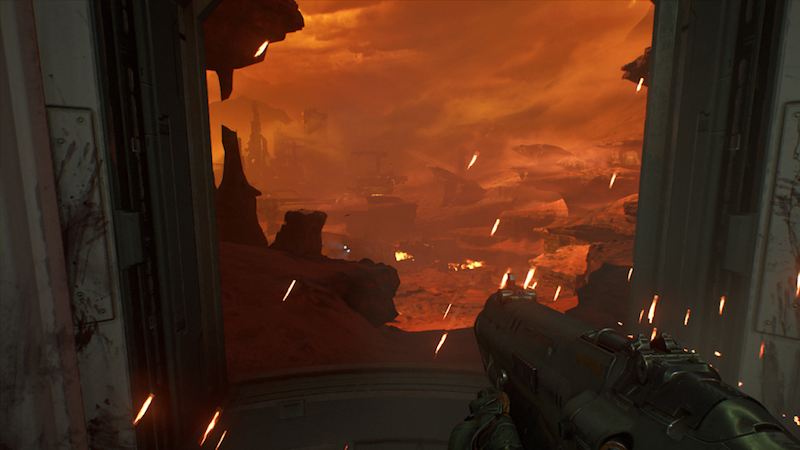
Enhancing and encouraging your movement are power-ups, temporary buffs that give you things like invincibility, increased movement speed and quad damage. Their short duration galvanises right back towards the thick of the fight, where you can make most use of the boosted stats.
The best of them, easily, is berserk. Pick it up and you holster your guns and raise your fists. For a short time you’re invincible, much faster and every time you hit an enemy you literally punch them into gobbets of meat. There is little more satisfying in Doom than becoming an invincible whirlwind of unrealistically explosive fists.
While the glory kills are the big new thing for Doom, there’s also a whole new upgrade system that underpins the campaign. Each of your weapons has two different fire modes that can be unlocked by tracking down a field drone — a hovering weapon shop that you often have to chase down. For your shotgun, for instance, you can unlock a grenade launcher that sits under the barrel or a mode where you can fire three shells in rapid succession. Only one of these can be active at once.
You can further upgrade the different weapon modes with tokens that you receive from completing optional objectives, killing a ton of enemies or by discovering secrets. Upgrades do things like increasing the shotgun grenade’s damage or how quickly it reloads. The final upgrade is unlocked by completing a challenge, rather than finding tokens. To turn my shotgun grenade into a cluster bomb I had to hit 20 imps directly with the grenade. It demands that you use the weapon skilfully, without being unrealistically difficult.
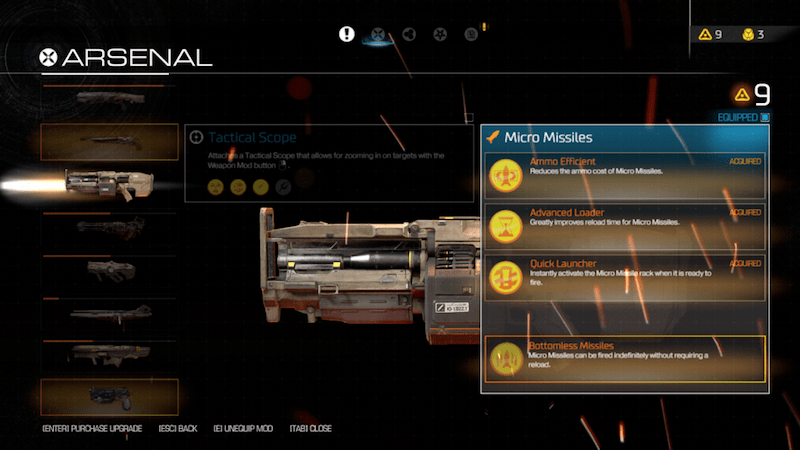
Your armour, too, can be upgraded by finding Preator tokens on the bodies of dead UAC elite guards. These let you unlock abilities (like faster gun switching), augmentations for powerups (like giving you full health whenever you pick one up) and new passives (like making your compass pulse when you’re near a secret). I used the armour tokens far less than the weapon tokens, as the upgrades were less exciting than the changes I could make to my guns, but it did make me a little more calculating when I chose to use a powerup. Rather than start a fight by picking up a powerup, I’d pick it up when times were tough because of the health boost it would give me.
The best collectibles are the Trial Runes you’ll find dotted throughout the campaign. These carved stones, when activated, will teleport you to a small challenge arena where you’ll need to do things like kill 30 enemies before the timer runs out, clear a room with only one point of health or get to the end of an obstacle course within a strict time limit. If you manage it, then you’re rewarded with a rune for your armour.
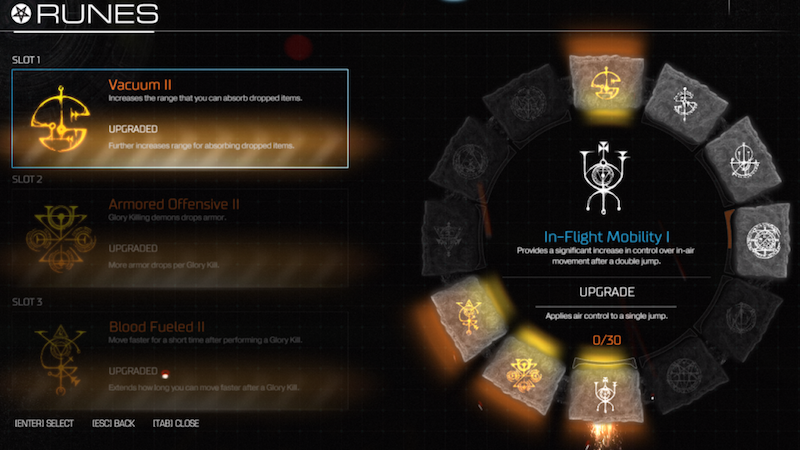
There are 12 runes in all, each giving you a different passive ability. You can only have three active at a time. I went with things like Blood Fuelled and Armoured Offensive: the first ups my movement speed whenever I perform a glory kill, the second means that executed enemies drop armour as well as health. A neat touch to runes is that the more you use them the better they get, giving you room to tailor things to how you play.
I really enjoyed the new Doom – it’s great to dive back into the pulse-raising slaughter fest of the ’90s style shooter again – but the final few hours of the campaign really dragged for me. It felt like I (and id) had run out of ways to change up the combat. Each new room would spawn in the same structure of enemy waves, starting with the smaller demons and ending on a clutch of the big as a house ones — the Barons of Hell, Mancubi and Pinkys. It was still a challenge, but not a fresh one. Perhaps if I hadn’t binged on the campaign, or if I’d played on a higher difficulty, this would have been less noticeable, but the earlier levels, where I was still getting new weapons, meaningful unlocks and coming across new enemy types, felt much more exciting. Nonetheless, since completing the campaign, I’ve been replaying levels, spending more time looking for secrets and rooting out those classic maps I can’t escape the draw of diving back into for just one more go.
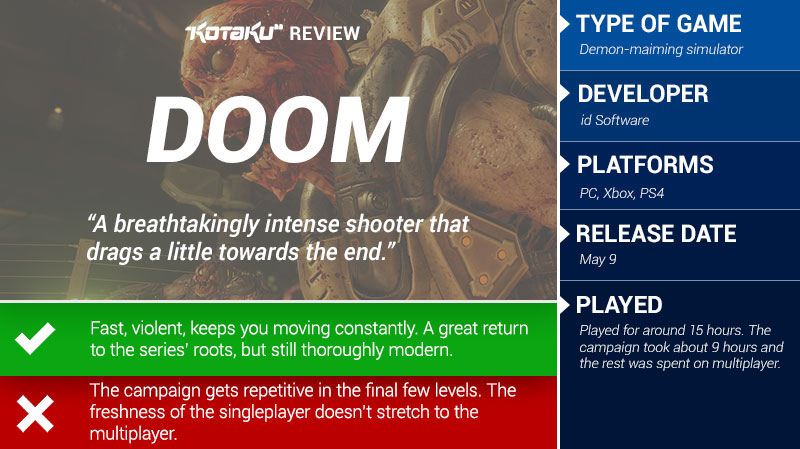
I cannot, sadly, say the same for the multiplayer. Doom‘s multiplayer isn’t bad; it’s just that while the single-player is something no one else is doing well at the moment, the multiplayer is very similar to other games, and comes across as decidedly average.
It comes with a predictable selection of modes, from team deathmatch to king of the hill, and throws in a couple of new ones like freeze tag, where you are trying to freeze every member of the opposing team to win, and you can unfreeze your teammates to keep the game going. These matches reward you with collectible cosmetic items. But it’s just not that much fun, certainly not in comparison to the single player. I’ve not come across any maps that have stood out as memorable or inspired. The armour types you can unlock are still just variations on an armoured spacesuit — I didn’t see any which made me think “I have to have that helmet/arm piece/chest plate.”
One thing I do like a lot about the multiplayer is that there are a number of guns in it I didn’t find in the campaign, as well as versions of the single player guns that work differently in multiplayer, such as the gauss cannon. In single-player, this high-powered beam weapon can be fitted with a scope that charges up a shot and makes it deal more damage. In multiplayer, it benefits from a scope that lets you see through walls and highlights players on the other team.
Also awesome: you can actually turn into a demon if you can get to the powerup before anyone else:
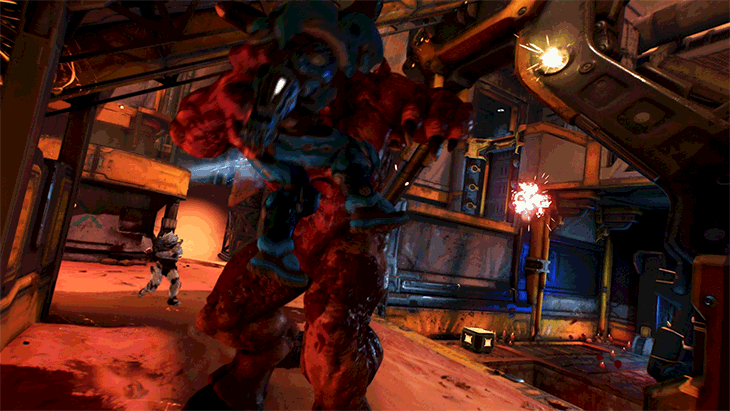
Whilst it’s not great at the moment, if Bethesda and id keep supporting Doom‘s multiplayer with more than just new cosmetics, it could become something good. It is, after all, an arena shooter from the makers of Quake Arena, one of the best multiplayer shooters of all time. Hopefully, too, players will embrace the map making tools shipped with Doom. That’s where we could see the memorable maps emerge, rather than from the developer itself.
id has steeped itself in the Doom games of the past to make this new Doom, drawing out the speed, freedom of movement and bewildering number of enemies that has always made Doom so intense. But in looking back to the past, the developer has made something that feels thoroughly modern, rather than weighed down by nostalgia. There is no other game I can turn to that will let me leap about a roomful of demons, firing a satisfyingly chunky assault rifle into the throng as beasts disintegrate into a bloody pulp. It sets my heart racing in a way that not even the original Doom managed.
Now, I’m going to see if I can beat this chap on nightmare:
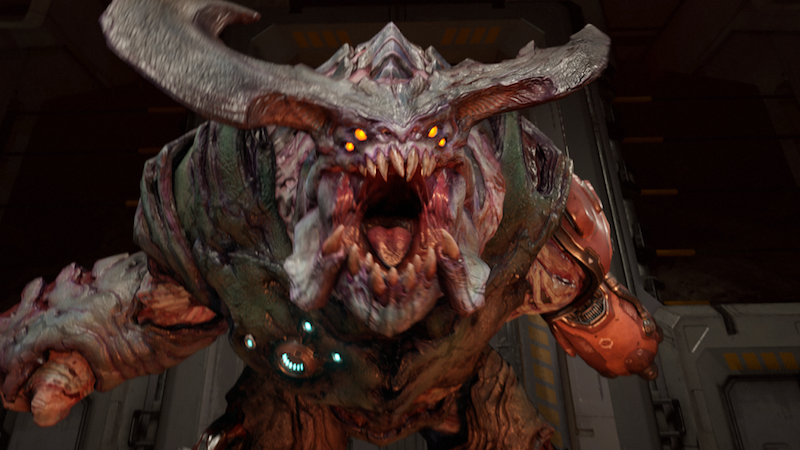

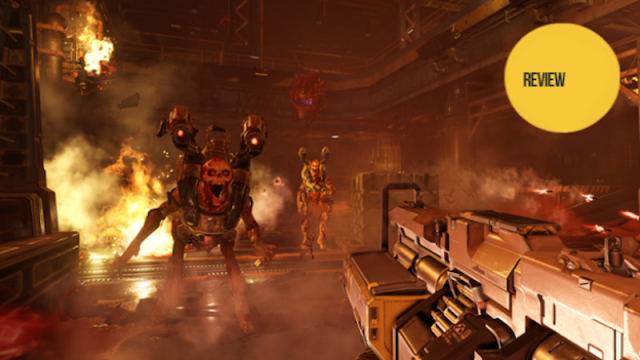
Comments
26 responses to “Doom: The Kotaku Review”
I sort of skimmed over the review in case it spoiled anything but boy am I relieved to know there’s a double jump upgrade I’ll find later, because in the first level there is a secret I simply can NOT get to without one and it was driving me nuts trying to figure it out.
I think I’ll stop trying to frantically look for all the secrets until a bit later. As it is I already replayed levels 1-3 before proceeding to 4. This could become an obsession if I don’t reign it in now.
You don’t need specific unlocks to get secrets on the early levels. They are all obtainable the first time through.
Well I have achievement hunter’s level 1 secrets guide queued up on youtube to watch later, maybe they’ll point out the obvious for me. Because I can where I need to go but despite twenty minutes of searching and pixel hunting, I couldn’t figure out how to reach it. A double jump would have made it simple.
Oh definitely, double jump makes everything easier. But once you see it you’ll be like, omg, how am I this blind. Just like what happened to me.
You know, I was just reflecting on the one I’m thinking about (I think it’s one of the elite guards with a praetor suit upgrade) and while I could be wrong I think I just figured out what I need to do. Could be remembering wrong though. There is a door that probably leads there that I just can’t figure out how to open, but maybe that door just opens from the inside.
ah I know what you’re referring to now, you can see the suit from down the bottom, but can’t jump high enough. Won’t say how, but yes another way to get to it.
I *think* I might be able to drop down from above, if not there MUST be a way to get the door open.
It’s a fun, fast paced game, far better than Rage. I hope they return to form with a quake game in similar vein.
Brilliant single player, much better than wolfenstein. haven’t played multiplayer.
Wolfenstein is one of the best campaigns I’ve played in a very long time.
I played the demo and didn’t really enjoy the multi much at all (not the biggest fan of twitch shooter multi). I was hoping the campaign was worth the price of admission alone. This review and “better than Wolfenstein” just sold me.
Wait… You did like Wolfenstein, right?
Story for doom is typical old school id – fuckin shite (wolfenstien was third party hence the better than average story).
Gunplay tho is amazing – the best i’ve had since quake days. The game just feels right, fast paced and meaty.
The Single Player is not better than Wolfenstein. That game was the tits and was more involved with the story.
Doom is more vague, but the gameplay is better.
Has a similar pace to Quake 3.
Yeh i loved parts of wolfenstein where the gunplay and dark nazi setting really gelled for me (seemed to be 2nd half after the 1hr long fetch quest middle part). Parts like castle wolfenstein and the moon.
Didnt like the story and over the top characters in Wolf at all. Doom has a similiar cheesy story but not as campy and they keep the breaks between action short.
Enjoy doom!
Just to a small note on my own playthrough.
I played on Ultra Violence until the last couple of levels, largely because I was running out of annual leave. It took me about 12 hours up until that point, because I’m a reckless moron. The rest of the campaign only took a couple of hours, courtesy of some large set pieces and boss fights.
My first playthrough was UV, and reckon it took about the same. Pretty decent game time for a balls-to-the-wall FPS shooter. Debating a Nightmare playthrough next – did Ultra Nightmare far enough to get the trophy, but that was enough for me.
Do you keep your weaponry/skills upon firing up Nightmare? Let me know, I’d be super interested in doing another run through if I could have double jump/everything straight off the bat.
I suppose you can just replay each level on the higher difficulty, but that’s not quite the same.
I haven’t tried it myself yet. I know you can change the mission difficulty, so when you go back and replay them, etc. But from memory I couldn’t raise it any higher than UV. Got a feeling Nightmare will require a new save.
I’m sticking to Hurt Me Plenty on my first playthrough and there’s still areas where I struggle so I’m glad I didn’t bump it up to Ultra. This is the right kind of challenge, I seldom feel cheated when I die.
I’m on Hurt Me Plenty too and there’s been a few areas that have taken me more than a few attempts but never gotten frustrated. Usually when I suddenly freeze up when a Baron charges unexpectedly around a corner or my frantic flailing around style of play gets me stuck in a corner between two Pinkys.
Did anyone load up multiplayer ready to gib people – saw the load out screen and frantically alt-f4’d ??? Why the fuck would they do that… Where’s the arena shooter with timers for weapons n shit.
Really should have paid more attention to the mp betas heh. Got my monies worth through the single player tho – much fun was had.
They should recreate Quake 3 maps, and have the gun pickups like Quake 3.
I’d play that all day.
Rocket arena… That was awesome wonder how it holds up today.
Man, I haven’t had this much fun in a video game for a long time. You know you’re doing something right where it leaves me cheering and clapping in the privacy of my own room.
I really enjoyed the singleplayer campaign.
I just wish they had spent more effort into the multiplayer, there is this weird divide between singleplayer, multiplayer and Snapmap. With all these being so split it’s hard to find any multiplayer games that aren’t team deathmatch on PC.
Whilst I understand this is Doom going back to its roots, I thoroughly enjoyed Doom 3 for its more horror-esque atmosphere and story (for what it was). I’d have liked to have seen a continuation on that theme, but I’ll stick check this out eventually. Just not straight away.
Absolutely loved the single player, absolutely hated the multiplayer. The multiplayer is just really bad. Loadouts and perks, random consumables, weapons that don’t hit hard and zero hit feedback that made it felt like I died after one one or two hits